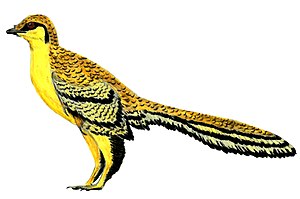Aurornis
| Aurornis | ||||||||||||
|---|---|---|---|---|---|---|---|---|---|---|---|---|

Illustration by Aurornis xui |
||||||||||||
| Temporal occurrence | ||||||||||||
| Jurassic ( Callovian to Kimmeridgian ) | ||||||||||||
| approx. 166.1 to 152.1 million years | ||||||||||||
| Locations | ||||||||||||
| Systematics | ||||||||||||
|
||||||||||||
| Scientific name | ||||||||||||
| Aurornis | ||||||||||||
| Godefroit et al., 2013 | ||||||||||||
| Art | ||||||||||||
|
||||||||||||
Aurornis is a genus of Theropods (Theropoda). Their only species , Aurornis xui , livedin eastern Eurasia during the Jura (around 152.1 to 166.1 mya ). The about 50 cm long aurornis was probably completely feathered, but probably only able to glide . The genus description is based on fossil material that was found in the northeast Chinese Tiaojishan Formation in the early 21st century. The genus was first described in 2013 by a research group led by Pascal Godefroit . They classified them as the oldest and most original representatives of the Avialae , which includes the birds (Aves) and their closest relatives.
features
Aurornis xui was a relatively small theropod with a body length of around 50 cm . The skull of the holotype is 57 mm long, its tail is very long compared to that of other basal paraves (around four times as long as the femur). The arms of the species were also relatively long and reached around 80% of the leg length. The body was covered with fine feather down ; A. xui probably had long shaft feathers on the legs, arms and tail like other paraves. The feathered arms were possibly used by the animals to help them run and jump.
ecology
Aurornis xui probably lived in a warm temperate to subtropical climate, which was characterized by high humidity. He presumably hunted his prey continuously.
Fossil material, stratigraphy and dissemination
Aurornis fossil material comprises the complete skeleton of an individual embedded in a slate of slate . The specimen was found during commercial excavations near Daxishan in the Chinese province of Liaoning in the early 21st century . It comes from the Tiaojishan Formation and came into the possession of the Yizhou Fossil & Geology Park via a fossil dealer , where it is listed under the inventory number YFGP-T5198. The age of the specimen is difficult to determine: the Tiaojishan Formation has a complex stratigraphy , and individual pieces can only be dated by means of extensive microfossil analyzes. Chronostratigraphic investigations of the formation place them in a period of 165 ± 1.2 to 153 ± 2 mya . Aurornis xui would have lived in the Callovian ( Middle Jurassic ) or Kimmeridgian ( Upper Jurassic ). At that time, the site was on the western edge of Eurasia , which was isolated from North America and Gondwana by the northern shelf seas of the Tethys .
Systematics and taxonomy
|
|||||||||||||||||||||||||||||||||||||||||||||||||||||||||
| Systematic position of Aurornis according to Godefroit et al. (2013). According to this cladogram, the species is the most original representative of the Avialae . |
The skeleton from the Tioajishan Formation was examined by Pascal Godefroit , Andrea Cau , Hu Dong-Yu , François Escuillié , Wu Wenhao and Gareth Dyke and determined to be the holotype of a new genus and species in 2013 . Using a phylogenetic analysis of 101 taxa on the basis of 992 osteological features, they classified the fossil at the base of the Avialae , i.e. the most extensive family group that includes birds, but not the Troodontidae and Dromaeosauridae . At the same time, the analysis located the genus Archeopteryx , whose membership of the birds was previously questioned by Xu Xing and colleagues, also within the Avialae. From the point of view of the authors, Aurornis thus represents the oldest and most original bird in the broader sense, while the precursor position of Archaeopterix was underpinned. The authors chose the generic name Aurornis ( Latin "aurora" for dawn, Greek "ornis" for bird) based on the age and the original position in the bird family tree. They dedicated the specific epithet xui to Xu Xing, whose phylogenetic theses they contradicted in their article, but to whom they nevertheless paid respect for his research on Mesozoic birds and their closest relatives.
swell
literature
- Pascal Godefroit, Andrea Cau, Hu Dong-Yu, François Escuillié, Wu Wenhao, Gareth Dyke: A Jurassic avialan dinosaur from China resolves the early phylogenetic history of birds . In: Nature . tape 498 , no. 7454 , 2013, p. 359-362 , doi : 10.1038 / nature12168 .
- Chris Woolston: New contender for first bird . In: Nature . 2013, doi : 10.1038 / nature.2013.13088 .
- Xing Xu, Hailu You, Kai Du, Fenglu Han: An Archeopteryx-like theropod from China and the origin of Avialae . In: Nature . tape 475 , no. 7357 , 2011, p. 465-470 , doi : 10.1038 / nature10288 .
Individual evidence
- ↑ a b c Godefroit et al. 2013, pp. 1–2.
- ↑ Godefroit et al. 2013, ESM p. 6.
- ↑ a b Woolston 2013. Retrieved May 31, 2013.
- ↑ Godefroit et al. 2013, pp. 7–8.
- ↑ Godefroit et al. 2013, p. 4.
- ↑ Xu et al. 2011, p. 469.
- ↑ Godefroit et al. 2013, pp. 2–8.